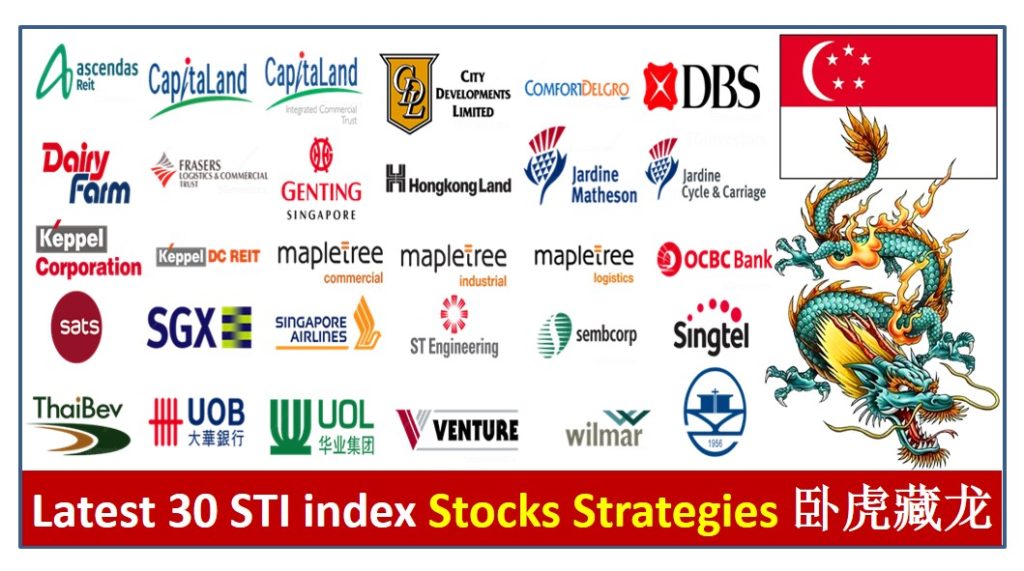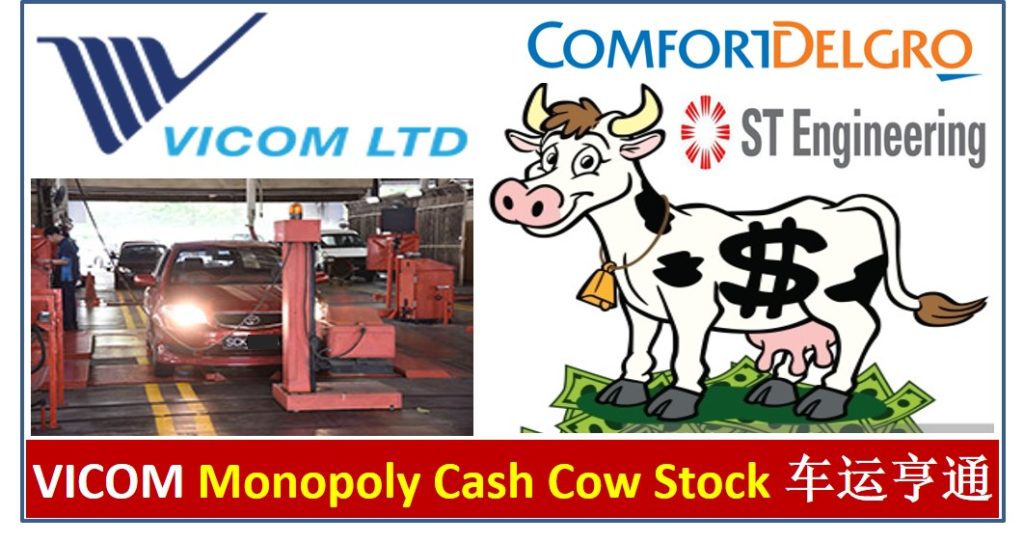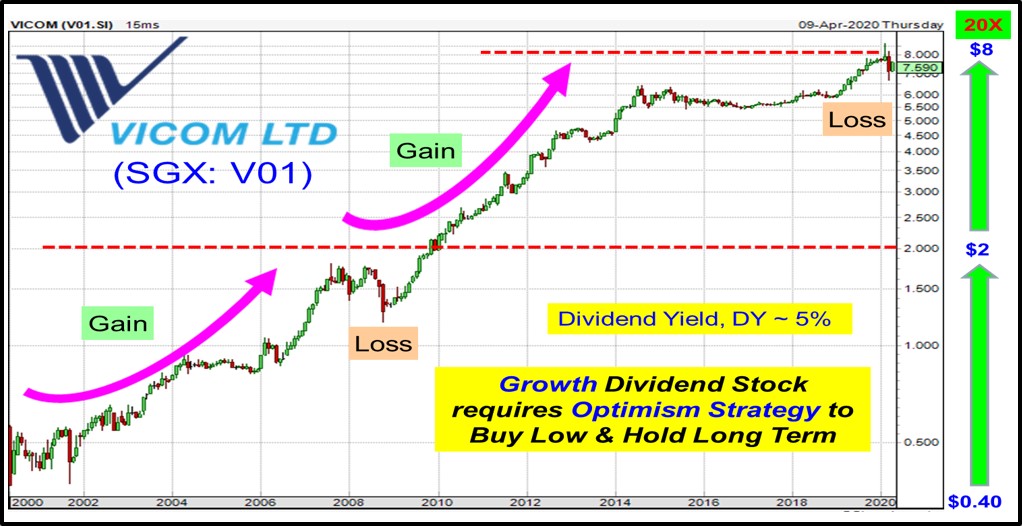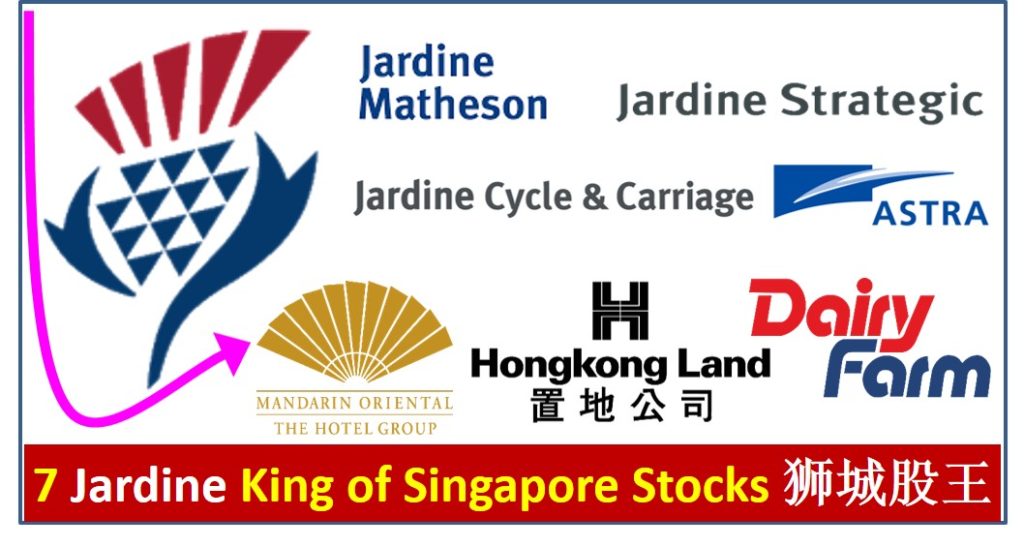
30 STI index stocks represent the overall Singapore stock market performance. The list is dynamic, recent new comers are Keppel DC Reit (replacing SPH) and Frasers Logistics and Commercial Trust (replacing Jardine Strategic Holdings). During the COVID-19 stock recovery, there is a sector rotation, investors start to pay more attention to cyclical stocks (eg. bank, properties and transportation sectors, etc), which are main businesses of 30 STI stocks.
In this article, you will learn from Dr Tee on the Latest 30 STI Index Stocks Strategies, some may be considered for longer term investing and / or short term trading with COVID-19 recovery stock rally. Bonus for readers who could read every words of the entire article, learning unique strategy to position in 30 STI Index stocks for both passive incomes (dividend) and capital gains with potential share price appreciation. Both Ein55 Optimism levels and intrinsic values will be shared for 6 groups of STI stocks with potential. Learn key applications of ALL 30 STI stocks with 1 article here:
4 Banking & Finance STI Stocks (35% of STI):
– DBS Bank (SGX: D05), OCBC Bank (SGX: O39), UOB Bank (SGX: U11), Singapore Exchange (SGX) (SGX: S68)
4 Property STI Stocks (9% of STI):
– CapitaLand (SGX: C31), City Development (SGX: C09), Hongkong Land (SGX: H78), UOL (SGX: U14)
7 REITs STI Stocks (11% of STI):
– Ascendas Reit (SGX: A17U), CapitaLand Integrated Commercial Trust (CICT) (SGX: C38U), Frasers Logistics & Commercial Trust (SGX: BUOU), Keppel DC Reit (SGX: AJBU), Mapletree Commercial Trust (SGX: N2IU), Mapletree Industrial Trust (SGX: ME8U), Mapletree Logistics Trust (SGX: M44U)
4 Jardine STI Stocks (14% of STI):
– Jardine Matheson Holdings – JMH (SGX: J36), Jardine Cycle & Carriage (SGX: C07), Hongkong Land (SGX: H78), Dairy Farm International (SGX: D01)
4 Transportation STI Stocks (6% of STI):
– ComfortDelGro (SGX: C52), Singapore Airlines (SIA) (SGX: C6L), SATS (SGX: S58), Yangzijiang Shipbuilding (YZJ) (SGX: BS6)
8 Other Sectors STI Stocks (27% of STI):
– Genting Singapore (SGX: G13), Keppel Corp (SGX: BN4), ST Engineering (SGX: S63), Sembcorp Industries (SGX: U96), Singtel (SGX: Z74), Thai Beverage (SGX: Y92), Venture Corporation (SGX: V03), Wilmar International (SGX: F34)
Investing in stock index of a country with growing economy (eg. Singapore STI, China A50 / Hong Kong HSI, USA S&P500 and Nasdaq, Malaysia KLCI, etc) is a defensive strategy as the stock index is well diversified over a portfolio of large cap stocks (卧虎藏龙) from various sectors, able to minimize unsystematic risks due to uncertainties in businesses and sector cycles. An investor may invest in stock indices with ETFs (Exchange Traded Fund), eg. STI Singapore has 2 ETFs: SPDR STI ETF (SGX: ES3) and Nokko AM STI ETF (SGX: G3B), can be traded like any stock. This provides a way for small capital investor to diversify in investment with minimal capital, eg. 1 STI ETF equals to investing in 30 STI stocks at the same time with different weightages.
The best time to buy 30 STI stocks or index ETF is always during global stock crisis (eg. Year 2020-2021 during pandemic, 2008—2009 during subprime crisis, etc), not only able to maximize the dividend yield (due to lower entry share price), also could have higher potential of capital gains (when market cycle moves from fear in low optimism to greed in high optimism). STI Index stocks investing is not for dividend collection alone, may be integrated with growth investing, swing trading, momentum trading, cyclic investing, defensive investing, undervalue investing and other Ein55 strategies.
30 STI index stocks represent the 30 largest stocks by trading market capitalization (trading price x trading volume). Therefore, not all are giant stocks (based on Dr Tee giant stock criteria). Below are the 30 STI index component stocks based on the last price traded (20 Apr 2021), sorted by 6 main groups with details of 3 key Fundamental Criteria:
1) ROE (a criteria for growth stocks, eg. ROE > 5%),
2) Dividend Yield, DY (a criteria for dividend stocks, eg. DY > 3%),
3) Price-to-Book (PB) ratio, Price/NAV (a criteria for undervalue stocks, eg. PB < 1).
From the table sorted below, over 50% (18/30 STI stocks) have growing businesses (over 5% ROE, Return on Equity) while 7 stocks were making losses during pandemic in Year 2020. With recovery of pandemic, there are only 20% (6/30 STI stocks) are still undervalue (Price to Book ratio, PB < 1). There are over 50% (16/30 STI stocks) have dividend yield over 3%, potential for dividend investing. STI ETF has an average dividend yield of about 3%, may be considered as replacement for long term fixed deposit but it requires a stock crisis to start this saving scheme at lower Ein55 optimism level to minimize the potential capital loss due to emotional stock market.
However, not all the 30 STI index stocks listed are giant stocks. A growing business in the past may not be sustainable during COVID-19 period, could end up as a crisis stock. Fundamental Analysis alone is not sufficient, a high dividend yield stock may be a value trap as this may be the result of lower share price with weakening businesses. Therefore, deeper analysis is required with LOFTP (Level, Optimism, Fundamental, Technical, Personal Analysis) Strategies.
| No | 30 STI Stocks | ROE (%) | PB | DY (%) |
| 1 | Ascendas Reit (SGX: A17U) | 4.97 | 1.4 | 4.8 |
| 2 | CapitaLand Integrated Commercial Trust (CICT) (SGX: C38U) | 2.683 | 1.1 | 4.0 |
| 3 | CapitaLand (SGX: C31) | – | 0.9 | 2.4 |
| 4 | City Development (SGX: C09) | – | 0.9 | 1.0 |
| 5 | ComfortDelGro (SGX: C52) | 2.371 | 1.5 | 0.8 |
| 6 | DBS Bank (SGX: D05) | 8.642 | 1.4 | 3.0 |
| 7 | Dairy Farm International (SGX: D01) | 20.5 | 4.4 | 3.9 |
| 8 | Frasers Logistics & Commercial Trust (SGX: BUOU) | 12.06 | 1.3 | 4.8 |
| 9 | Genting Singapore (SGX: G13) | 0.884 | 1.4 | 1.1 |
| 10 | Hongkong Land (SGX: H78) | – | 0.3 | 4.4 |
| 11 | Jardine Matheson Holdings JMH (SGX: J36) | – | 1.6 | 2.7 |
| 12 | Jardine Cycle & Carriage (SGX: C07) | 8.073 | 1.0 | 2.4 |
| 13 | Keppel Corp (SGX: BN4) | – | 0.9 | 1.8 |
| 14 | Keppel DC Reit (SGX: AJBU) | 8.647 | 2.3 | 3.4 |
| 15 | Mapletree Commercial Trust (SGX: N2IU) | 9.385 | 1.2 | 3.8 |
| 16 | Mapletree Industrial Trust (SGX: ME8U) | 10.31 | 1.6 | 4.1 |
| 17 | Mapletree Logistics Trust (SGX: M44U) | 8.235 | 1.5 | 3.6 |
| 18 | OCBC Bank (SGX: O39) | 7.227 | 1.1 | 2.7 |
| 19 | SATS (SGX: S58) | 10.41 | 3.0 | 1.4 |
| 20 | Singapore Exchange (SGX) (SGX: S68) | 37.9 | 8.9 | 2.9 |
| 21 | Singapore Airlines (SIA) (SGX: C6L) | – | 1.3 | 0.6 |
| 22 | ST Engineering (SGX: S63) | 22.76 | 5.4 | 3.8 |
| 23 | Sembcorp Industries (SGX: U96) | – | 1.2 | 1.8 |
| 24 | Singtel (SGX: Z74) | 4.011 | 1.6 | 4.8 |
| 25 | Thai Beverage (SGX: Y92) | 15.96 | 2.9 | 3.4 |
| 26 | UOB Bank (SGX: U11) | 6.902 | 1.1 | 3.0 |
| 27 | UOL (SGX: U14) | 0.134 | 0.7 | 2.2 |
| 28 | Venture Corporation (SGX: V03) | 11.5 | 2.3 | 3.7 |
| 29 | Wilmar International (SGX: F34) | 8.125 | 1.4 | 2.4 |
| 30 | Yangzijiang Shipbuilding (YZJ) (SGX: BS6) | 7.781 | 0.8 | 3.3 |
Here, let’s focus on 30 STI Index Component Stocks in Singapore over 6 main groups (Hongkong Land is counted twice under both Jardine Stock & Property Stock), learning the unique positioning:
4 Banking & Finance STI Stocks (35% of STI):
====================================
– DBS Bank (SGX: D05), OCBC Bank (SGX: O39), UOB Bank (SGX: U11), Singapore Exchange (SGX) (SGX: S68)
3 major banks in Singapore (DBS, OCBC, UOB – all are giant stocks with close relative performance in medium term) are key pillars to STI, contributing to 33% or 1/3 of STI. Therefore, price movement and business changes in Singapore banks or financial sector would affect STI direction significantly. With improvement of pandemic condition, all 3 Singapore major banks reported better quarterly results. As a result, the share prices have recovered from lower optimism level, currently near to their respective intrinsic values. This implies the cyclic upside potential of DBS, OCBC and UOB are limited (unless there is another global financial crisis to buy low in future), share prices would grow gradually along their intrinsic values with time.
Main current strategy for 3 bank stocks could be momentum trading (Buy High Sell Higher) with support of increasing bank interest rate (improving interest income with higher NIM, Net Interest Margin) over the next few years. When Asian stock market are over-price (exceeding intrinsic values) with greedy market emotions, STI may achieve a new historical high, bank stock investors may need to plan for exit strategy at higher Ein55 Optimism level. Meanwhile, Singapore bank stocks are still suitable for long term dividend investing, especially if 60% dividend payout cap (based on FY2019) may be lifted by MAS from Q2/2021, then dividend yield would increase by 50%, achieving normal dividend yield of nearly 5% (comparable with REITs), an excellent alternative to cash deposit in banks or even Singapore Savings Bond which has only 0.5% interest rate yearly, becoming negative return when inflation is over 1%.
Singapore Exchange (SGX) is a moderate growth stock due to a monopoly business model, regardless of bullish or bearish stock market, as long as there is higher demand to buy or sell stocks, earnings would increase. With challenges from Hong Kong Stock Exchange (HKEX: 388) who wins the MSCI Future business, Singapore Exchange has to explore new derivatives and widen the customer base to more global investors. Intrinsic value of Singapore Exchange is about $13, still undervalue at the moment, having upside potential but patience is required due to moderate growth.
Even if an investor could not buy any Singapore bank stock, may follow Ein55 Optimism strategy to buy STI index at low optimism (<25%) during pandemic, recovery from 2200+ to 3200+ points, the reward could be 30% – 50% in 1 year, depending on the timing of entry when “others are fearful”.
Readers may read earlier article (June 2020 during pandemic with low optimism prices) by Dr Tee for more details on 30 Banking & Finance stocks in Singapore, not limited to STI:
https://www.ein55.com/2020/06/30-singapore-banking-and-finance-stocks/
4 Property STI Stocks (9% of STI):
=============================
– CapitaLand (SGX: C31), City Development (SGX: C09), Hongkong Land (SGX: H78), UOL (SGX: U14)
4 major property stocks in Singapore (CapitaLand, City Development, Hongkong Land and UOL) are undervalue in nature (PB < 1), only contributing to 9% of STI. With recovery of pandemic, lower optimism levels of property stocks start to appreciate in share prices but still below their intrinsic values currently. For example, Hongkong Land has nearly 2X potential from current share price of $5 to its intrinsic value of about $9 but it has a new variable of stagnant Hongkong property market. Despite Hongkong Land is listed in Singapore, main property business is located in Hong Kong, devaluation of Hong Kong properties results in accounting losses in FY2020 but cashflow is not affected, therefore able to pay consistent dividend as if a REIT (dividend yield of 4-5%).
Among all 4 STI property stocks, City Development has the weakest business fundamental (partly due to setback in China investment with Sincere Property), therefore even if share price has the most discount, this could be a value trap for longer term investor, therefore a lower quality of crisis stock. UOL and CapitaLand are relatively stronger in businesses. Despite Singapore property construction business was affected during pandemic, actual property price is growing up gradually. Therefore, Singapore property stocks are likely to recover strongly after pandemic.
Temasek stock, CapitaLand, will be delisted in near future after recent restructuring, replacing with another potential new giant stock, CLIM (investment asset management company which focus on growth investing). In future, the undervalue CapitaLand may be listed again with higher premium price, a better option than continue the current listing with long term undervalue price under the theme of property stock.
Similar to bank stocks, Singapore property stocks are also cyclical in nature, more suitable with Buy Low Sell High strategy. STI property stocks also could be a defender with dividend investing, especially for Hongkong Land, almost behaving like a Reit with steady dividend payment (except not required by law). Since Singapore property stocks are undervalue in nature, this is a layer of safety measure for long term investor as the asset value is more than its current share price. However, if major shareholder decides to delist an undervalue property stock at low optimism level, then minority shareholders may not gain much after sharing the pain of holding in long term. Therefore, when Singapore stock market and property market rise to a higher optimism level, a property stock investor may consider the exit strategy (Sell High and Buy Low next time), no need to hold for long term.
Readers may read earlier article (June 2020 during pandemic with low optimism prices) by Dr Tee for more details on 47 Undervalue Property Stocks in Singapore, not limited to STI:
https://www.ein55.com/2020/06/47-undervalue-sg-property-stocks-for-privatization-including-perennial/
7 REITs STI Stocks (11% of STI):
==========================
– Ascendas Reit – Areit (SGX: A17U), CapitaLand Integrated Commercial Trust – CICT (SGX: C38U), Frasers Logistics & Commercial Trust – FLCT (SGX: BUOU), Keppel DC Reit (SGX: AJBU), Mapletree Commercial Trust – MCT (SGX: N2IU), Mapletree Industrial Trust – MIT (SGX: ME8U), Mapletree Logistics Trust – MLT (SGX: M44U)
The earlier 2 new comers of STI are MIT and FLCT, both are REITs, The 4 STI reserved list (for future consideration, eg. after replacement of CapitaLand after it is delisted) are all REITs or Trust related stocks, showing the increasing demand for defensive dividend investing: Keppel REIT, Suntec REIT, Frasers Centrepoint Trust and NetLink NBN Trust.
7 STI REITs in Singapore (Areit, CICT, FLCT, Keppel DC Reit MCT, MIT, MLT) are all giant REITs for dividend investing, the ideal time to invest was during pandemic when “others are fearful” in 2020 with over 30% price correction at low Ein55 Optimism level, resulting in higher dividend yield over 4 to 7%. “Buy Low” is only applicable for giant stocks, otherwise “Buy Low” may become lower for weak fundamental stocks.
Most of these 7 STI REITs have recovered to near or even above their intrinsic values, except CICT is still at moderate low optimism, having over 20% discount below its fair value, growth is slow but steady. MCT is close to its intrinsic value but slower growth. Both MLT and FLCT are at higher Ein55 Optimism levels, supported by logistics business with higher demand during pandemic.
Singapore REITs in general only have moderate dividend yield after recovery from pandemic so far. A few non-STI REITs with high dividend yield could be a value trap with weaker business, driving lower prices and therefore higher dividend yield). Dividend yield should not be the main selection criteria of a giant REIT.
These 3 industrial STI REITs (Keppel DC Reit, MIT, Areit) have strong uptrend momentum during the early stage of pandemic (industry sector business was not much affected during circuit breaker time) but suffering in sector rotation when pandemic condition improves in later stage, share prices were corrected more than 20% over the past few months, currently under second round of price recovery, may be considered for medium term trading with trend-following strategies, applying S.E.T. (Stop Loss / Entry / Target Prices) in trading plan. All these 3 STI REITs have partial business related to high growth data center (100% for Keppel DC Reit, 30% for MIT, 10% for Areit) with higher demand in internet applications during and post pandemic.
In summary, 7 STI REITs are excellent choices for dividend investing but the best time for investing is always when “others are fearful” during Global Financial Crisis with low Ein55 Optimism level. Currently these giant REITs are more suitable for medium term dividend investing or even trading with trend-following strategies. Unlike property market, REITs are hybrid of stocks and properties, therefore they are cyclic in nature, an investor could suffer significant capital loss when buying at high Ein55 Optimism level with downtrend prices, especially near to peak of stock market.
Readers may read earlier article (June 2020 during pandemic with low optimism prices) by Dr Tee for more details on 42 REITs and 16 Business Trusts in Singapore, not limited to STI:
https://www.ein55.com/2020/06/42-singapore-reits-16-business-trusts/
4 Jardine STI Stocks (14% of STI):
=============================
– Jardine Matheson Holdings – JMH (SGX: J36), Jardine Cycle & Carriage – JCC (SGX: C07), Hongkong Land (SGX: H78), Dairy Farm International (SGX: D01)
Jardine group of stocks are influential to STI, even with delisting of JSH, these 4 Jardine giant stocks (JMH, JCC, Hongkong Land and Dairy Farm) still dominate 14% of STI by market cap. Currently, all these 4 Jardine STI stocks are recovering together from very low Ein55 Optimism level, partly supported by the corporate news of acquisition of JSH by JMH, triggering speculation on potential next undervalue Jardine stock to acquire which may surge in prices.
In fact, acquisition of a giant stock at low optimism (eg. JSH) should be a nightmare for a long term investor, despite a premium price (typically about 20%) is given for the offer to minority shareholders. For long term investor who bought a stock at higher optimism level, even could hold a stock for long term or lifetime, may not able to stop the major shareholder from leveraging on low optimism opportunity to delist a company at undervalue prices (including CapitaLand, JSH and many other good fundamental stocks), a few may even end up with losses as entry price at high optimism is higher than the acquisition price.
Therefore, to minimize systematic risks (eg. global financial crisis, sector correction, etc), investing in a portfolio of 10-20 giant stocks at lower Ein55 Optimism with strong holding power could improve the probability of winning in investment. Stock market in short term is a voting machine (up and down daily, sensitive to news) but in a long term, it becomes a weighing machine (steady growth in years with support of growing business).
All the 4 Jardine STI stocks are aligned with recovery of share prices from low Ein55 Optimism levels. They are considered laggard stocks (slower in recovery from pandemic), limited number of giant stocks with higher upside cyclic potential. However, Jardine stocks are cyclical in nature, stock price volatilities may be beyond the risk tolerance level of some traders or even investors.
Readers may read earlier article (Apr 2020 during the worst time of pandemic with very low optimism prices) by Dr Tee for more details on 7 Jardine Group of Giant Stocks, not limited to STI:
https://www.ein55.com/2020/04/7-jardine-king-of-singapore-stocks/
4 Transportation STI Stocks (6% of STI):
===================================
– ComfortDelGro (SGX: C52), Singapore Airlines (SIA) (SGX: C6L), SATS (SGX: S58), Yangzijiang Shipbuilding (YZJ) (SGX: BS6)
There are 4 transportation STI stocks: ComfortDelGro (land transportation), Singapore Airlines (airlines), SATS (partial airlines), Yangzijiang Shipbuilding (shipping). Transportation sector in general is badly affected during pandemic but strongly supported by government grants, therefore these stocks start to recover with slow business improvement in later stage of pandemic. Stock market is always forward looking, most people believe pandemic would end sooner or later, therefore global vaccination starts to recover the share prices of transportation stock, despite their businesses are still weak.
ComfortDelgro is mainly on taxi business, also has bus / MRT / car inspection businesses through subsidiaries SBS Transit (SGX: S61) and Vicom (SGX: WJP). The impact of pandemic is much less than the airlines sector, mainly affected during circuit breaker time (Q2/2020) when most people stay at home. Share price of ComfortDelgro was cut by nearly half during pandemic, then share price starts to recover from low Ein55 Optimism. Intrinsic value of ComfortDelgro is about $2.50, there is cyclic upside potential in share price with diminishing fear, supported by low community cases of COVID-19 in Singapore, allowing land transportation business to go back to normal. Vicom as a more defensive dividend stock (but dividend yield is moderate after rising in share prices after 4-to-1 stock split) with stable and predictable car inspection business (nearly monopoly, sharing the pie with ST Engineering which has STA car inspection centers), supplying critical cashflow to major shareholder, ComfortDelgro (2/3 ownership of Vicom). SBS Transit has become an asset light company after LTA changes of its business model a few years ago (focusing as transport operator with lower expenses and more predictable incomes), gradually become a giant stock but Ein55 Optimism level is relatively high, more suitable for trading, not yet for investing.
YangZiJiang (YZJ) is in shipbuilding industry, relatively stronger than most shipping or marine related stocks with decade long of winter time in this sector. Pandemic in fact helps the shipping industry due to more intercontinental shipping activities. Baltic Dry Index (BDI, a measurement of inflation for shipping industry) has been surging since pandemic, a bullish business signal. However, YangZiJiang is cyclic in nature, limited growth in long term with moderate dividend yield (3%), more suitable for short term trading, especially when there is rising interest in shipping related stocks.
SIA is a truly crisis stock as airlines passengers drop more than 90%, even parent shareholder, Temasek has to take the lead to help with rights and bonds issues, in additional to Singapore government financial aids. However, the risk of SIA is not limited to pandemic, the gradual weakening of airlines business was shown even over the last 10 years before pandemic due to competitive airlines industry (eg. price competition for similar flight from City A to City B), similar to another “grandparents blue chip” stock, Singapore Press Holdings – SPH (SGX: T39) with declining business due to less readers (who access free info including news from internet) gradually over the decade. Despite both SIA and SPH are no longer giant stocks for longer term investing, they may be considered for short term trading (with trend-following strategies) due to speculation of recovery in pandemic, especially after their stock prices were cut by half during pandemic.
SATS is a spinoff company of SIA about 3 decades ago with about 60% airlines gateway business and 40% F&B business. SATS is indirectly affected by COVID-19 for airlines related business but it can still be compensated by F&B business, therefore a better financial position than most airlines stocks. In fact, SATS is relatively a better investing choice than SIA, considering both have about 50% price discount during pandemic but SATS has higher growth potential than SIA, therefore may be considered for both longer term investing (current price is only 15% below its intrinsic value) or even shorter term trading.
In fact, even an investor has a lousy stock with weak business fundamental, could not accept the fact of capital loss with “long term investing”, may apply the powerful “Change Horse” strategy, i.e. selling weaker stock, using the remaining capital recovered to buy another stronger stock on the same day. This is a psychological strategy to strengthen the mind of an investor (as if a stock is never sold, just changing its name), despite mistake could be made in the past, there is a second choice, no need to keep on holding to the same weaker stock, changing its future with a giant stock.
Readers may read earlier article (Mar 2020 during the worst time of pandemic with very low optimism prices) by Dr Tee for more details of “Change Horse” strategy (SATS and SIA as examples, assuming an investor only prefers airlines stock):
https://www.ein55.com/2020/03/change-horse-strategy-sia-to-sats/
8 Other Sectors STI Stocks (27% of STI):
==================================
– Genting Singapore (SGX: G13), Keppel Corp (SGX: BN4), ST Engineering (SGX: S63), Sembcorp Industries (SGX: U96), Singtel (SGX: Z74), Thai Beverage (SGX: Y92), Venture Corporation (SGX: V03), Wilmar International (SGX: F34)
The remaining 8 STI stocks come from various industries: Genting Singapore (casino), Keppel Corp (property / oil & gas), ST Engineering (technology), Sembcorp Industries (utility / property), Singtel (telecommunication), Thai Beverage (F&B), Venture Corporation (technology, Wilmar (commodity). They are aligned with average 3.3% weightage of each STI stock (100% / 30 stocks = 3.3% per stock), total 27% of STI by market cap for 8 stocks. However, due to less STI stocks in these miscellaneous sectors, therefore changes in each sector do not significantly affect STI index.
For example, early stage of pandemic supports share prices of high-tech stocks globally but STI had little gain due to lack of high-tech stocks, lagging behind comparing with US NASDAQ or even Hong Kong HSI indices. On the other hand, since global stock market currently value more on cyclic sectors (most of STI component stocks) with pandemic recovery, therefore STI is leading compared to global peers since early Year 2021. So, it is a blessing in disguise for STI to be lagging, so that late comers still have chance to enter the stock market with higher reward to risk ratio.
Among these 8 other sectors STI stocks, Singtel and Wilmar have the largest market cap. Singtel is a Temasek stock, a defensive dividend stock but telco overseas business overseas (contributing to over 50% revenue) is not as stable as in Singapore, therefore share prices have been corrected lower over the past few years, even before pandemic. Before pandemic, telco industry has been too competitive, over-saturated market with lower profit margins, many global and local telco stocks are affected with declining business (Singtel is still relatively stronger than other telco stocks). Although 5G technology could create a new wave of future business, most profits may go to smart phone / 5G leaders (eg. Apple, NASDAQ: AAPL) and semi-conductor (eg. TSMC, NYSE: TSM) supplier giant stocks. Singtel has started to recover from low Ein55 Optimism but not supported by growing business, may take more time to achieve intrinsic value of nearly $4. “Buy Low” in share price without growing business may fall into value trap in longer term (Buy Low Get Lower), therefore careful monitoring of future Singtel business is required for long term investing. Singtel is more suitable for trading currently.
Wilmar is a strong fundamental commodity stock with steady growth in palm oil and sugar businesses, supported by PPB (KLSE: 4065) of Kuok Group as major shareholder (head of Kuok family is Robert Kuok, the richest person in Malaysia while nephew, Kuok Khoon Hong, is Wilmar Chairman), aligning with recovery of commodity market including palm oil and sugar prices from lower Ein55 Optimism (supported further by weakening of US dollar with QE during pandemic). Wilmar share price follows its intrinsic value closely, therefore little opportunity to Buy Low unless there is a global financial crisis in future. Wilmar subsidiary with cooking oil business, YKA, is a new IPO stock in China stock market (larger market cap than Wilmar now due to higher demand in China stock market), would help to support the parent stock in longer term. In general, Wilmar can be a steady defender stock but may not be suitable for those who aim for quick gains.
Remaining 6 other STI stocks, each has its own pros and cons. Genting Singapore is a crisis stock, share price is recovering well from low Ein55 Optimism but business is limited by lack of international tourists to Singapore (potential customers for gambling business which is the main profit generator). Thai Beverage is a higher quality crisis stock, share price is recovering from very low optimism but beer business is not much affected by pandemic, short term price is affected due to recent news to delay IPO plan for its subsidiary, BeerCo. Thai Beverage’s intrinsic value is about $1, current price is about 30% below this fair value.
ST Engineering is a defensive technology stock, share price is recovering from low optimism in pandemic, near to its intrinsic value, more suitable for medium term dividend investing. Venture is a cyclic technology stock, more suitable for Buy Low Sell High (currently at high Ein55 Optimism level), more suitable for trading, may not for long term investing. There is a potential of Version 2.0 Dotcom bubble (Version 1.0 was in Year 2000) due to over-price global technology giant stocks, therefore investing in high tech stocks require trend-following trading strategies due to very high optimism in many technology stocks which could be fine for a period of time with support of growing economy after pandemic is over.
Keppel Corp is not supported by Temasek partial acquisition last year but share prices recover gradually with improvement in oil prices during pandemic (after the worst time of negative oil price in May 2020), but business is still declining, mainly supported by property market (eg. Keppel Land and Keppel Reit). Despite Keppel Corp plans to exit from Oil & Gas sector eventually in future, it could still benefit from the recovery of oil market as Keppel Offshore & Marine division may be merged with Sembcorp Marine (SGX: S51), another Temasek crisis stock, which is demerged recently from Sembcorp Industries. After demerging, Sembcorp Industries becomes a giant stock overnight (before demerging, 1/3 business was affected by subsidiary, Sembcorp Marine with losing business in oil & gas), share prices have recovered from low Ein55 Optimism in pandemic, near to its intrinsic value currently, supported mainly by growing land development business and defensive utility business.
Out of 30 STI Index stocks, there are 50% or 15 Temasek related stocks: DBS, Singtel, Sembcorp Industry, Keppel Corp, Keppel DC Reit, CapitaLand, CICT, SIA, SATS, ST Engineering, Singapore Exchange, Areit, MIT, MCT and MLT. Temasek as a major or significant shareholder, provides stability to business and even share prices to these Temasek stocks, especially during stock or business crisis (including non-STI stock such as Olam (SGX: O32) when it was attacked by Muddy Waters during shorting many years ago.
Readers may read earlier article (Aug 2020 during pandemic with low optimism prices) by Dr Tee for more details on 26 Temasek stocks, not limited to STI:
https://www.ein55.com/2020/08/temasek-giant-stocks-corporate-actions/
===================================
Between knowledge (eg. reading this educational article of 30 STI stocks) and fortune (eg. making profits in stocks), there is a bridge to cross called Action (Buy, Hold, Sell, Wait or Shorting). Before making any decision, reader may need to understand own personality, eg. short term trading or long term investing, risk tolerance level and reward expectation, etc, then aligned with the right strategies. Similar to each profession, stock trading and investment skills can be learned, even in a free way (you are doing the right way now) if one could put in effort consistently to learn and apply.
===================================
There are over 1500 giant stocks in the world based on Dr Tee criteria, choice of 10 Dream Team giant stocks have to align with one’s unique personality, eg. for shorter term trading (eg. momentum or swing trading) or longer term investing (cyclic investing, undervalue investing or growth investing). Readers should not just “copy and paste” any stock (What to Buy, When to Buy/Sell) as successful action taking requires deeper consideration (LOFTP strategies – Level / Optimism / Fundamental / Technical / Personal Analysis) which you could learn further from Dr Tee Free 4-hr Webinar.
Drop by Dr Tee free 4hr webinar (learning at comfort of home with Zoom) to learn how to position in global giant stocks during COVID-19 stock crisis with 10 unique stock investing strategies, knowing What to Buy, When to Buy/Sell.
Zoom will be started 30 min before event, bonus talk (Q&A on any investment topics from readers) for early birds. There are many topics we will cover in this 4hr webinar, Dr Tee can have more time for Q&A if you could stay later after the webinar, you could ask on any global and local stocks including but not limited to 30 STI component stocks:
Ascendas Reit (SGX: A17U), CapitaLand (SGX: C31), CapitaLand Integrated Commercial Trust (SGX: C38U), City Development (SGX: C09), ComfortDelGro (SGX: C52), Dairy Farm International (SGX: D01), DBS Bank (SGX: D05), Genting Singapore (SGX: G13), Hongkong Land (SGX: H78), Jardine Cycle & Carriage (SGX: C07), Jardine Matheson Holdings JMH (SGX: J36), Jardine Strategic Holdings JSH (SGX: J37), Keppel Corp (SGX: BN4), Keppel DC Reit (SGX: AJBU), Mapletree Commercial Trust (SGX: N2IU), Mapletree Industrial Trust (SGX: ME8U), Mapletree Logistics Trust (SGX: M44U), OCBC Bank (SGX: O39), SATS (SGX: S58), Sembcorp Industries (SGX: U96), Singapore Airlines (SGX: C6L), Singapore Exchange (SGX: S68), Singtel (SGX: Z74), ST Engineering (SGX: S63), Thai Beverage (SGX: Y92), UOB Bank (SGX: U11), UOL (SGX: U14), Venture Corporation (SGX: V03), Wilmar International (SGX: F34), YZJ Shipbldg SGD (SGX: BS6).
Dr Tee will cover over 20 case studies, Singapore giant stocks, eg. CapitaLand Mall Trust (SGX: C38U), Singapore Exchange (SGX: S68), Keppel Corp (SGX: BN4), Top Glove (SGX: BVA), Jardine Matheson Holdings JMH (SGX: J36), Vicom (SGX: WJP) and many others, Malaysia giant stocks, Hong Kong giant stocks and US giant stocks, both long term investing and short term trading.
There are limited tickets left for this 4hr free webinar, please ensure 100% you could join when register: www.ein55.com






